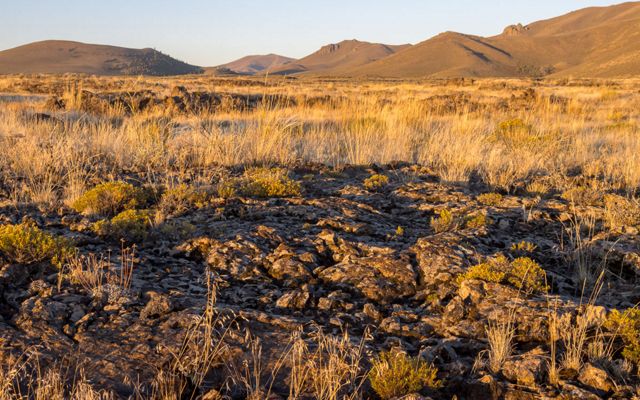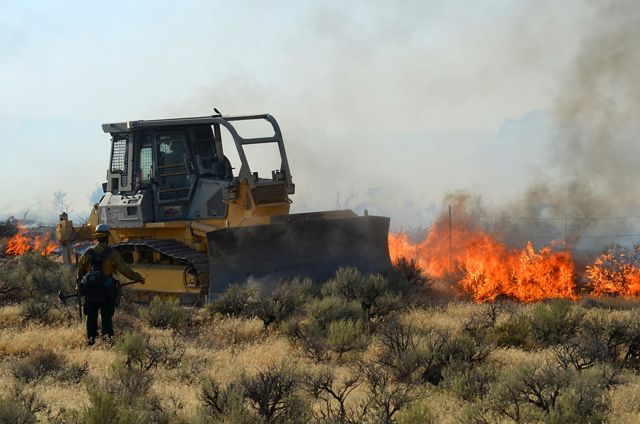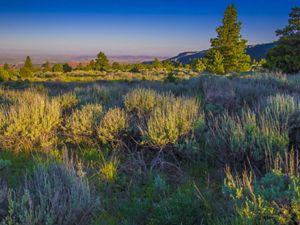Battling Invasives: The Race to Restore the Sagebrush Sea
Partners Test Technology with Promising Potential
By Larisa Bowen, Senior Writer/Editor, Western US and Canada Division
Underestimating the Sagebrush Sea is a common mistake. Too many of us overlook it, distracted by the West’s more boldly charismatic landscapes. But our indifference is costing us. Not only is the Sagebrush Sea a complex, fascinating ecosystem that’s vital to people and nature, but it’s also ground zero for an increasingly urgent battle.
Noxious annual grasses are steadily invading sagebrush landscapes and displacing native plants, which are the fabric of healthy ecosystems. The consequences of this assault are grave: more frequent, damaging mega-fires; economic hardships for ranchers; and a devastating loss of habitat for sagebrush-dependent wildlife.
With the stakes rising, and invasives dominating, a team of diverse partners seeks to even the odds. The Nature Conservancy (TNC), the USDA Agricultural Research Service (ARS), the National Park Service (NPS) and Germains Seed Technology have joined forces to field test a special seed coating designed to give the Sagebrush Sea’s native plants a critical boost. While their efforts build on years of research, this team’s push for a tool with large-scale impact is part of a growing national epiphany: it’s time to pay attention to the Sagebrush Sea—and to do more, faster, to save it.

Crisis at America’s Core
Many of us dismiss sagebrush country as “empty.” Mark Twain, of course, was not so foolish. He described sagebrush shrublands as “the forest in exquisite miniature.” Exquisite indeed. And surprisingly biologically rich. Spanning 14 states and three Canadian provinces, the Sagebrush Sea is actually comprised of thousands of native plants and animals. In addition to the keystone species of sagebrush, which are crucial to hundreds of animals, there is also a wealth of other native perennial bunchgrasses and wildflowers which all flourish in between and under the sagebrush canopy. In a carefully balanced and synchronized system, these hardy plants share the arid region’s limited resources, and together they provide crucial benefits: from native wildlife habitat and soil stability to water storage and livestock forage. It’s this unique tapestry of life in the Sagebrush Sea that supports livelihoods, provides resources and recreation opportunities, and sustains biodiversity.
But all of this—Twain’s “forest in miniature”—is now being consumed and replaced by a near-monoculture of invasive plants. And it’s happening fast. Once the most widespread vegetation type in western North America, sagebrush used to cover one-third of the continental United States. Today, less than half remains, and much of that is degraded. Each year, we lose another 1.3 million acres of this vital habitat to drought, conversion, energy development, improper grazing and atypical wildfire. But the impact of all of these threats pales in comparison to the damage caused by the single greatest menace: invasive annual grasses.


According to figures from the U.S. Geological Survey, about 100 million acres of sagebrush are now moderately or highly threatened by cheatgrass alone, one of the more well-known invaders. This figure doesn’t account for the sagebrush landscapes increasingly colonized by medusahead and ventenata, two other noxious grasses that are triggering alarm bells from California to Colorado as scientists warn that they may be even more invasive than cheatgrass. These two newcomers, along with cheatgrass, have now earned an ominous moniker: the Triple Threat.
This invasion is one that Sara Ihrie knows well. She faces it every day as the biological science technician lead at Craters of the Moon National Monument and Preserve, an otherworldly landscape of vast lava fields mixed with sagebrush that stretches across central Idaho’s Snake River Plain.

“Cheatgrass,” Ihrie shakes her head. “Where do I start?” She quickly ticks off a list: “Cheatgrass just fills in spaces, which is terrible for greater sage-grouse and other animals that call this place home. And then it also can become a monoculture, which is, again, not good for resilience or biodiversity. And it also increases our fire cycle time.”
Ihrie is hitting on the key characteristics that make the “Triple Threat” invasives so dangerous to these ecosystems and their inhabitants:
- They out-compete native vegetation, stealing the region’s limited water and soil resources.
- They grow fast, filling in the gaps between native vegetation like sagebrush, bluebunch wheatgrass and balsamroot.
- They grow early in the season and then die by summer, drying out and leaving the ground covered in a continuous, dry tinder that is extremely flammable.
- They reduce the quantity and duration of livestock forage, putting pressure on other landscapes and impacting the economies of rural communities.
- They are hardy and too widespread to ever completely remove in many highly invaded areas.
- They thrive in areas disturbed by development, drought or fire.

A Growing Ring of Fire
As Ihrie notes, one of the most dangerous consequences of annual grass invasion in the Sagebrush Sea is how these species are wreaking havoc with fire. The “grass-fire cycle” looks like this: dry, abundant invasive grasses ignite like tissue paper, fueling more frequent fires that carry across landscapes faster than before. In the wake of those burns, the invasives then grow back more quickly than native plants—outcompeting them and setting the scene for larger, more frequent and dangerous fires. The vicious cycle repeats and compounds. Areas that once experienced fire an average of once every 30 to 150 years may experience fires an average of once every 3 to 5 years after cheatgrass or other invasives move in. What makes this situation worse? Drought and heat driven by a changing climate, which increase the potential for fires and make it harder for native plants to establish.
“These are the wildfires that threaten lives and put out of business people who depend on these landscapes for their ranching operations or for recreation,” says Matt Cahill, TNC’s Sagebrush Sea program director. “They also generate huge amounts of smoke, which suffocate cities and towns hundreds of miles away.”
For the wildlife of the Sagebrush Sea, the impact of invasives and this altered cycle of fire is no less disastrous. In the winter, greater sage-grouse feed entirely on sagebrush leaves. Year-round, these iconic birds need healthy stands of sagebrush and native understory plants to provide protection and food for themselves and their chicks. Invasive grasses provide little to no habitat or food for the birds. At this point, experts estimate the populations of greater sage-grouse have decreased by at least 80% over the last several decades. As Ihrie points out, the sage grouse are just one species suffering—there are hundreds of others at risk, including pygmy rabbits, pronghorn, mule deer and a range of birds like Brewer's sparrows, sagebrush sparrows and sage thrashers. “There are so many unique plants and animals that live on this landscape,” she says, “and so much of it has been converted to either agriculture or housing, or otherwise converted to annual grassland, unfortunately. This is a unique place, and it's absolutely worthy of any kind of protection we can give it.”
Wildlife of the Sagebrush Sea






Getting Creative—and Sneaky—for Nature
Ihrie, and the landscape she cares for at Craters of the Moon National Monument and Preserve, are now part of an exciting pilot program to test an inventive solution for stopping the invasive rampage across sagebrush country. Ihrie is working with Roxanne Rios, a scientist with USDA Agricultural Research Service (ARS), and Dusty Perkins, the land stewardship manager for TNC’s Idaho Chapter, to try something new: protect the native plant seeds while killing the invasives with herbicides.
“After a fire, a land manager would normally apply a pre-emergent herbicide to kill invasives,” explains Rios, a rangeland management specialist for ARS who has been leading the upfront lab testing on the seed enhancement technology. “But managers often have to wait for a year before returning to seed the treated area with native plants. And that’s because the herbicide will kill all the seeds—it does not distinguish between the invasives and native plants.”

What ARS and TNC scientists have developed and fine-tuned over several years through dozens of lab and field trials is basically a cloak of protection—a special carbon coating for native seeds that shields them as managers use a pre-emergent herbicide to eliminate nearby cheatgrass and other annual invasives. The idea is that this innovative restoration technology would allow the land managers to seed native grasses in the same year as they apply herbicide—buying the native seedlings a crucial year of growth without fierce competition from invasives. Once native seeded bunchgrasses establish and survive in strong enough numbers, they can often push back against invasive species to interrupt the grass-fire cycle.
“You really get to take advantage of that first year when there’s little to no cheatgrass,” says Rios. “We’re hoping that extra year with limited competition from cheatgrass will help our native perennials establish.” While these types of seed manipulations have been used for various purposes in commercial agriculture, they were largely untested in wildland restoration. And, with the team in field-testing mode, the jury is now out.
Ground Truthing and Awaiting Results

While TNC and ARS scientists had seen promising results in the laboratory, the team knew it was time for the real test. Will this technology work in the often harsh conditions of sagebrush country? In the fall of 2023, ARS and TNC installed seed-coating test sites at four National Parks with vulnerable sagebrush ecosystems. In addition to Craters of the Moon National Monument and Preserve, test plots are also located at City of Rocks National Reserve in Idaho, Grand Teton National Park in Wyoming and Great Basin National Park in Nevada. The trial compares herbicide-treated plots that are seeded with uncoated or “bare” bluebunch wheatgrass seeds to those herbicide-treated plots planted with seeds that have the special protective coating. Bluebunch is a common native bunchgrass that co-occurs with sagebrush and provides important habitat and forage for native wildlife and livestock.
“A year from now, we hope to see that our carbon-coated seeds have been protected from the pre-emergent herbicide,” Rios says. “So, we expect the plots with bare seed to hardly have any plant emergence. But in plots where we’ve got coated seed, we hope to see some emergence."
Setting Up Test Plots



If the specially coated seeds do succeed, the team is poised to “go big” thanks to another vital partner: Germains Seed Technology, based in Gilroy, California. Germains will provide the materials as well as the industry and engineering expertise to turn this technology into a scalable and commercially viable seed treatment. Seventy percent of sagebrush ecosystems occur on public lands, so in the fight against invasives, government agencies will play a key role in adopting and using new tools, like the protective seed coating, in enough places to have real impact.
“Germains is really thinking about what it looks like to scale this and to develop production lines that are going to be able to bring it together so it can have impact at scale,” Perkins notes.

Team Hope
This year, the team is anxiously waiting and monitoring the test plots at the National Parks. They know that no matter what emerges from the soil, they are making crucial inroads in what will be a long battle to restore this important American ecosystem. Aside from the innovative technology they’re testing, all of the team members stressed another valuable aspect of this project: extraordinary collaboration.
“These are complicated problems,” explains Perkins, who joined TNC’s Idaho Chapter in 2021 after spending more than a decade teaching biology at the College of Western Idaho. “They require unconventional partnerships. And this partnership between ARS, the National Park Service, The Nature Conservancy and Germains is a great example of folks bringing their innovations and their strengths together to solve a complex problem.”
Perkins makes a key point. Each organization brings something unique to the table: USDA ARS provides the scientific expertise, NPS delivers the on-the-ground capacity and application, Germains Seed Technology is developing industry scalability and TNC is serving as the bridge and convener, connecting the partners and driving for large-scale results. This is a team that truly crosses borders, jurisdictions, specialties and spheres of influence.

Ihrie, from her position at Craters of the Moon National Monument, underscores the value of the alliance: “We co-manage our land with the Bureau of Land Management, and I think it’s just so exciting that public land managers are able to work with The Nature Conservancy to learn lessons and better protect our bigger landscape and our sagebrush steppe ecosystem as a whole.”
It’s a lesson taken straight from nature: diversity and cooperation are not just healthy; they are critical. To save a special, complex ecosystem, we need all hands on deck. Thankfully, more and more Americans are realizing this is an epic battle whose outcome matters to all of us. As Perkins notes, much is at stake: “Part of my soul is etched into this landscape from spending time wandering the sage steppe, whether as a sportsman or as a naturalist,” Perkins says. “This place inspires hope and opportunity. While the Sagebrush Sea provides really great wildlife habitat, it’s also crucial for recreation and for livestock operations. We have so many communities that depend on this land as the backbone for their economies.”
Keep Up to Date on Stories Like These
Sign up to receive monthly conservation news and updates from TNC.




